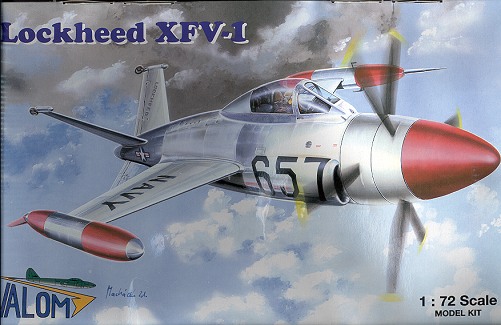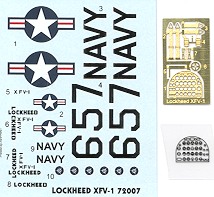
| KIT: | Valom 1/72 Lockheed XFV-1 |
| KIT #: | 7207 |
| PRICE: | $32.98 ($29.96 at Squadron) |
| DECALS: | One option |
| REVIEWER: | Scott Van Aken |
| NOTES: | Limited run with vac canopy and PE fret |

| HISTORY |
Realizing that it would not always be possible to have an aircraft carrier in with shipping convoys, the US Navy started looking for options. Vertical take off and landing seemed to be a viable option and in 1948, the Navy put forth specifications for a ship-based fighter that could land and take off from a pad on a cargo ship. Lockheed and Convair took the bait with Convair producing the XFY-1 'Pogo', while Lockheed worked on the XFV-1. Both were to be powered by the T-40 Turboprop and contra-rotating props.
It was this engine that would be part of the downfall of the projects, for the initial versions were incapable of prolonged high power output. This basically meant that it couldn't pull the aircraft from the vertical. This was a major problem for the XFY-1 as its design was such that it had to take off vertically. Lockheed's aircraft, however, was able to be rigged with large fixed landing gear so at least flight testing could get underway while awaiting a higher powered engine. The first flight of the XFV-1 was in mid 1954 and several dozen test flights were made in this configuration. This included vertical transitions while airborne so the project was feasible. Meanwhile the lone high power XT-40 was supplied to Convair who began testing, though engine problems were still rampant. Eventually it was becoming clear that engine development was going to be prolonged and coupled with the realization that the average pilot would have problems with vertical landing, especially on a moving ship, the program was terminated while the second prototype was still under construction.
Your editor can remember seeing either this aircraft or the semi-complete second prototype in a white and orange scheme up against hangars at ALF Imperial Beach in the mid-1980s, though it soon disappeared from there, hopefully to a museum where it can be restored.
| THE KIT |
 Valom
has become known for producing some very interesting and unusual prototype
and short production aircraft. Not only that, but they have kept to their
production schedule, a rather rare occurrence in today's market. When you
open the box, you get one well molded sprue of plastic with nicely engraved
panel lines, a pair of vacuformed canopies, a small photo etch fret with
the instrument panel, rudder pedals, a pitot tube, oleo scissors for the
'tail wheels' when using the fixed gear, and seat belts. There is also an
acetate instrument sheet.
Valom
has become known for producing some very interesting and unusual prototype
and short production aircraft. Not only that, but they have kept to their
production schedule, a rather rare occurrence in today's market. When you
open the box, you get one well molded sprue of plastic with nicely engraved
panel lines, a pair of vacuformed canopies, a small photo etch fret with
the instrument panel, rudder pedals, a pitot tube, oleo scissors for the
'tail wheels' when using the fixed gear, and seat belts. There is also an
acetate instrument sheet.
The injected parts are free from flash
and sink areas as well as ejector pin holes. Only a few small towers are
present inside the fuselage. The cockpit is well detailed with side walls
and consoles having raised detailing. While the props are not geared to
contra-rotate, there is a long shaft that will permit them to turn. All the
joins for the flight surfaces are butt joins so one needs to take care in
assembling these parts to ensure alignment. The kit provides the optional
fixed landing gear that the prototype spent its life upon. To be accurate,
this should be attached, but I'd bet that most of us will want to build
ours  unencumbered! The
vacuform canopies are a bit 'soft' in the frame line demarcations and the
same can be said about some of the smaller parts as well. I personally
would have liked to have seen the little landing gear 'bullets' molded in
with the fins instead of being separate, but one is given a couple of
extras in case some disappear.
unencumbered! The
vacuform canopies are a bit 'soft' in the frame line demarcations and the
same can be said about some of the smaller parts as well. I personally
would have liked to have seen the little landing gear 'bullets' molded in
with the fins instead of being separate, but one is given a couple of
extras in case some disappear.
Instructions are typical of all Valom's kits. A nice history is provided on the first page with a parts layout and color/markings diagram on the back page. The inside of the instructions are seven construction steps. Multiple views are provided for correct placement of the interior bits and there are also extra drawings for other parts. A front and side drawing is given to help ensure proper alignment of components. A color chart given FS 595, Humbrol, Aga, Gunze and Model Master color references where they apply. A very nicely printed decal sheet with markings for the lone flying prototype are provided.
| CONCLUSIONS |
Once again, Valom has provided a most interesting kit for those who are as fascinated as I am by these subjects. The kits show improvements in each new edition and this one appears to be the best of the lot so far. If you are wanting to give your hand a try at a limited run kit, this one would be a good place to start.
May 2005
A big thank you to Valom for supplying the review kit. You can find this kit and many others at

If you would like your product reviewed fairly and quickly by a site that has nearly 300,000 visitors a month, please contact me or see other details in the Note to Contributors.